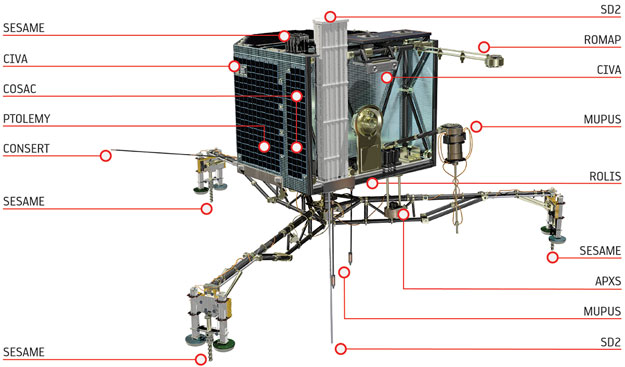Video and Image: Rosetta Mission Results from Philae 14 November 2014

The European Space Agency provided and early morning update on the Rosetta mission discussing primarily the science results. Since the last update yesterday, ESA has decided not to fire the anchor harpoons which were need to secure the Philae lander on the surface on the comet.
As well, drilling did start successfully even though the lander isn’t secured. Data was received by the Rosetta orbiter. The Alpha Proton X-ray Spectrometer (APXS) was also started and began chemical analysis of the landing site.
Currently telemetry from the lander has stopped and will not resume until 3:00 p.m. EST (2100 GMT) though it may be an hour afterwards before the data is received. ESA is not sure there will be enough power for the lander to communicate again. By drilling they may have used the last of the landers power. The ESA team would like to “bounce” out of their current position but that seems unlikely.
The Google Hangout was hosted by Emily Baldwin – ESA Science Editor
Participants included:
– Andrea Accomazzo – ESA Rosetta Flight Director, ESOC
– Stephan Ulamec – Philae Lander Manager, DLR
– Matt Taylor – Rosetta Project Scientist, ESA
– Philippe Gaudon – CNES Rosetta Project Manager, SONC
– Holger Sierks – PI for OSIRIS, Max-Planck-Institute for Solar System Research
– Valentina Lommatsch – DLR-Lander Control Center, mission team
– Jeff Grossman – OSIRIS-REx Program Scientist, NASA

The Philae lander has 10 instruments:
– APXS: Alpha Proton X-ray Spectrometer (studying the chemical composition of the landing site and its potential alteration during the comet’s approach to the Sun)
– CIVA: Comet Nucleus Infrared and Visible Analyser (six cameras to take panoramic pictures of the comet surface)
– CONSERT: COmet Nucleus Sounding Experiment by Radiowave Transmission (studying the internal structure of the comet nucleus with Rosetta orbiter)
– COSAC: The COmetary SAmpling and Composition experiment (detecting and identifying complex organic molecules)
– PTOLEMY: Using MODULUS protocol (Methods Of Determining and Understanding Light elements from Unequivocal Stable isotope compositions) to understand the geochemistry of light elements, such as hydrogen, carbon, nitrogen and oxygen.
– MUPUS: MUlti-PUrpose Sensors for Surface and Sub-Surface Science (studying the properties of the comet surface and immediate sub-surface)
– ROLIS: Rosetta Lander Imaging System (providing the first close-up images of the landing site)
– ROMAP: Rosetta Lander Magnetometer and Plasma Monitor (studying the magnetic field and plasma environment of the comet)
– SD2: Sampling, drilling and distribution subsystem (drilling up to 23 cm depth and delivering material to onboard instruments for analysis)
– SESAME: Surface Electric Sounding and Acoustic Monitoring Experiment (probing the mechanical and electrical parameters of the comet)
Backgrounder: Philae’s Descent and Science on the Surface Animation








